Introduction
In the rapidly evolving landscape of software development, microservices orchestration has emerged as a pivotal strategy for organizations aiming to enhance operational efficiency and agility. This approach involves the automated management of microservices-based applications, enabling seamless interaction and lifecycle management among diverse services.
As businesses strive to respond swiftly to market demands, the importance of effective orchestration cannot be overstated; it not only fosters scalability and fault tolerance but also streamlines deployment processes.
With the projected growth of the microservices orchestration market reaching $18.12 billion by 2032, organizations must navigate both the advantages and challenges presented by this paradigm shift.
This article delves into the definition, benefits, and best practices associated with microservices orchestration, while also highlighting key tools and real-world applications that exemplify its transformative potential in today’s digital environment.
Understanding Microservices Orchestration: Definition and Importance
Microservices orchestration tools automate the management of microservices-based applications, ensuring that diverse services function together seamlessly. This involves using microservices orchestration tools to coordinate interactions among small services, manage their lifecycle, and guarantee cohesive operation. The importance of service coordination is highlighted by its ability to boost scalability and enhance fault tolerance, which can be achieved through the use of microservices orchestration tools to simplify deployment procedures.
By effectively utilizing microservices orchestration tools to coordinate small services, companies can attain remarkable agility, responding swiftly to evolving market demands and optimizing operational workflows. However, it's important to note that 10% of organizations have separate DevOps and security teams with minimal collaboration, which can present challenges in achieving effective coordination. As noted by Kseniia Vyshyvaniuk:
By 2015, Netflix was operating over 700 small-scale services in production, enabling rapid development and deployment of new features.
This strategic choice demonstrates the competitive advantage that microservices offer and reflects the industry's trend towards microservices management, which is anticipated to experience a surge in adoption, projected to rise to $18.12 billion by 2032 from a valuation of $2.94 billion in 2023. Significantly, the Asia-Pacific area is expected to show the highest growth rate during this time, highlighting the crucial relevance of coordination in contemporary applications and its role in sustaining a competitive edge in the rapidly evolving technology environment.
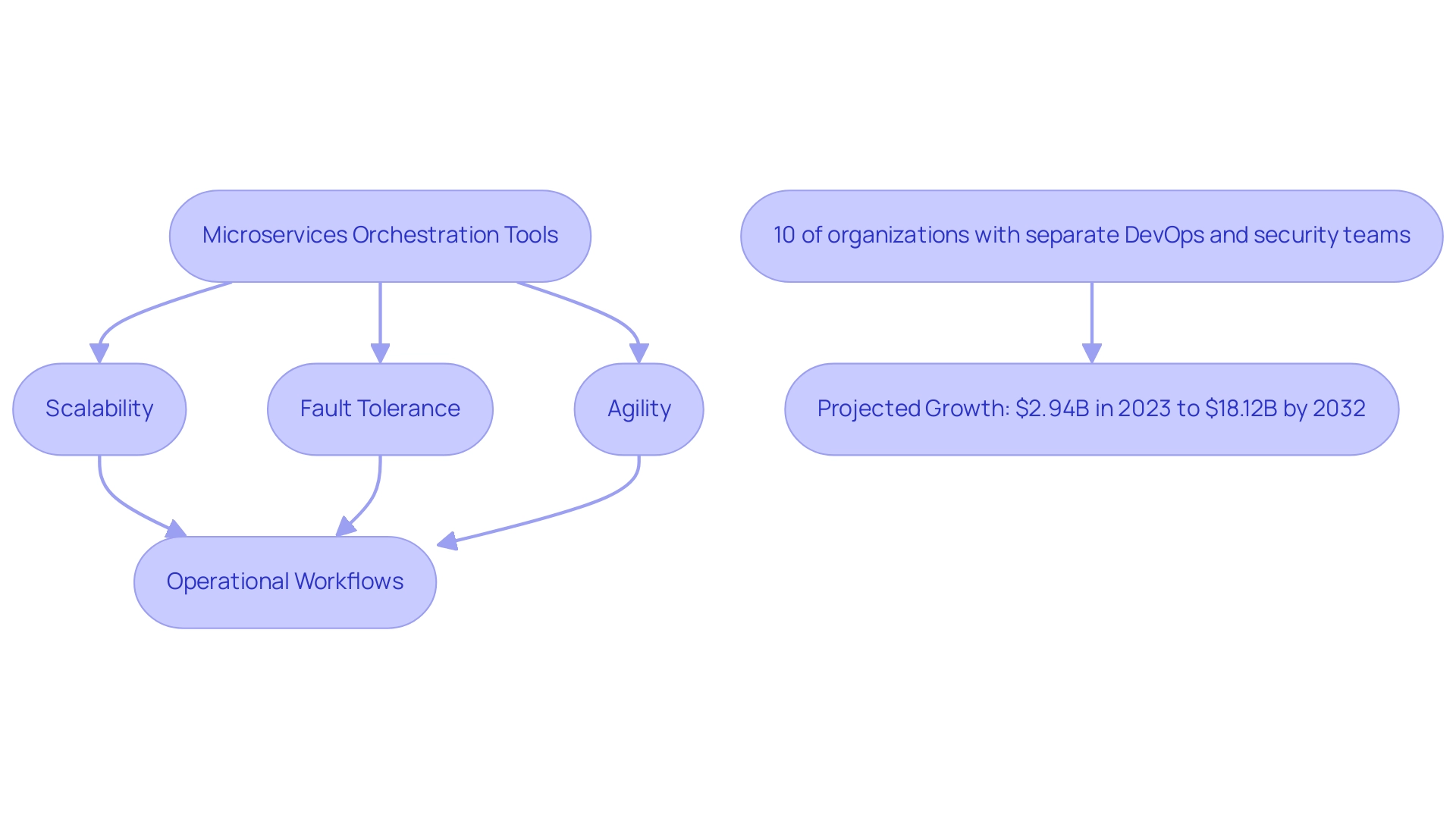
Benefits and Challenges of Using Microservices Orchestration Tools
Microservices orchestration tools provide a variety of advantages that are essential for contemporary organizations. Notably, microservices orchestration tools enhance scalability by enabling the independent deployment and management of services, which directly contributes to a faster time-to-market for new features and products. For example, by 2015, Netflix was effectively managing over 700 small services in production, illustrating how efficient coordination can foster rapid innovation.
Furthermore, these resources significantly enhance operational efficiency through automation of routine tasks, which minimizes the risk of human error—an essential consideration for maintaining service quality. However, the implementation of microservices orchestration tools presents its own set of challenges. Organizations often encounter increased complexity in managing distributed systems, which can lead to difficulties in troubleshooting and maintenance, highlighting the importance of microservices orchestration tools.
Additionally, there is a risk of vendor lock-in, which can limit flexibility and adaptability in a rapidly changing technological landscape. The learning curve associated with new tools can pose another barrier, requiring teams to invest in training and development. Moreover, robust monitoring is essential to ensure system reliability, particularly as 78% of containers are reported to use less than 80% of their requested memory, with 45% utilizing less than 30%.
As Cody Slingerland, a FinOps certified practitioner, observes, the environment of service management is changing, with an increasing number of entities acknowledging the necessity to combine security with observability and monitoring to tackle dynamic security threats. This proactive approach is further supported by a case study titled 'Unifying Security and Observability,' which reveals that 72% of respondents are integrating security with observability and monitoring. This highlights the significance of a thorough plan in handling the complexities of distributed services.
Moreover, the use of cookies on our website improves user experience, ensuring that visitors can navigate and interact with the content effectively, which further supports the operational objectives of entities utilizing microservices orchestration tools.
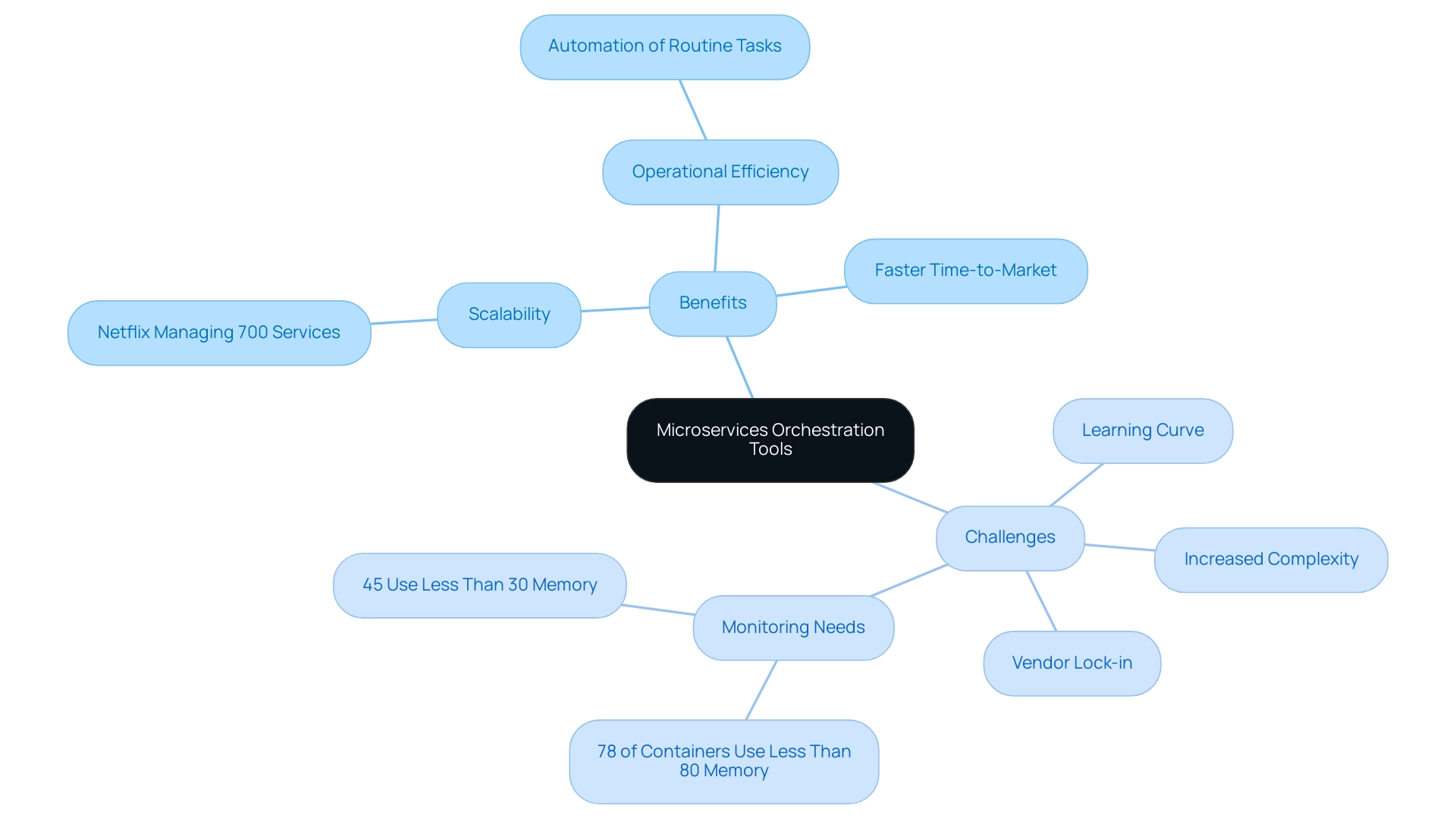
Top Microservices Orchestration Tools to Consider
-
Kubernetes: As a leading management platform, Kubernetes automates the deployment, scaling, and administration of containerized applications. Its robust features include service discovery, load balancing, and self-healing capabilities, enabling organizations to enhance operational efficiency and reliability. The market for such coordination tools is projected to reach $13.14 billion by 2028, with a CAGR of 19.7%, underscoring the significant growth potential in this area.
-
Docker Swarm: A crucial component of the Docker ecosystem, Docker Swarm provides native clustering and management functionalities, simplifying the administration of a cluster of Docker hosts. This integration streamlines operations and fosters seamless container deployment. As mentioned in the Architectural, Engineering Consultants And Related Services Global Market Report 2024, the demand for efficient microservices orchestration tools is driven by the growing complexity of service-oriented architectures.
-
Apache Mesos: This powerful open-source platform abstracts CPU, memory, storage, and other resources, delivering efficient resource management for microservices. Mesos allows organizations to enhance resource usage across various applications, making it a valuable asset in multi-cloud environments.
-
Amazon ECS: As a fully managed container orchestration service, Amazon ECS enables users to run and scale containerized applications on AWS effortlessly. Its seamless integration with other AWS services provides a comprehensive ecosystem for developers seeking scalability and reliability.
-
Red Hat OpenShift: Built on Kubernetes, OpenShift offers a comprehensive set of developer and operational tools for deploying and managing applications in hybrid cloud environments. Its emphasis on security and compliance makes it a preferred choice for enterprises navigating complex regulatory landscapes. This aligns with the major trend in the microservices architecture market highlighted by the partnership between Westech and Red Hat, which aims to revolutionize the use of microservices orchestration tools.
-
HashiCorp Nomad: Nomad is a versatile orchestrator capable of handling both containerized and non-containerized applications. Its flexibility enables entities to adopt a variety of deployment strategies, making it suitable for diverse operational needs.
-
Azure Kubernetes Service (AKS): This managed Kubernetes service simplifies the deployment and management of Kubernetes clusters on Microsoft Azure. AKS provides integrated monitoring and scaling features, empowering organizations to optimize performance and reduce operational overhead.
-
Google Kubernetes Engine (GKE): GKE offers a managed environment for deploying containerized applications using Google Cloud infrastructure. With built-in security and scalability features, it supports enterprises in achieving robust application performance and security compliance.
-
Jenkins X: An open-source solution focused on CI/CD for Kubernetes, Jenkins X facilitates automated deployment of applications within a service-oriented architecture. This tool enhances development efficiency, reducing the time from code commit to production.
-
Service Fabric: Created by Microsoft, Service Fabric is a platform for small, independent services that simplifies the deployment, management, and scaling of these services across both on-premises and cloud environments. Its architecture enables the seamless incorporation of modular services, enhancing overall application resilience and flexibility.
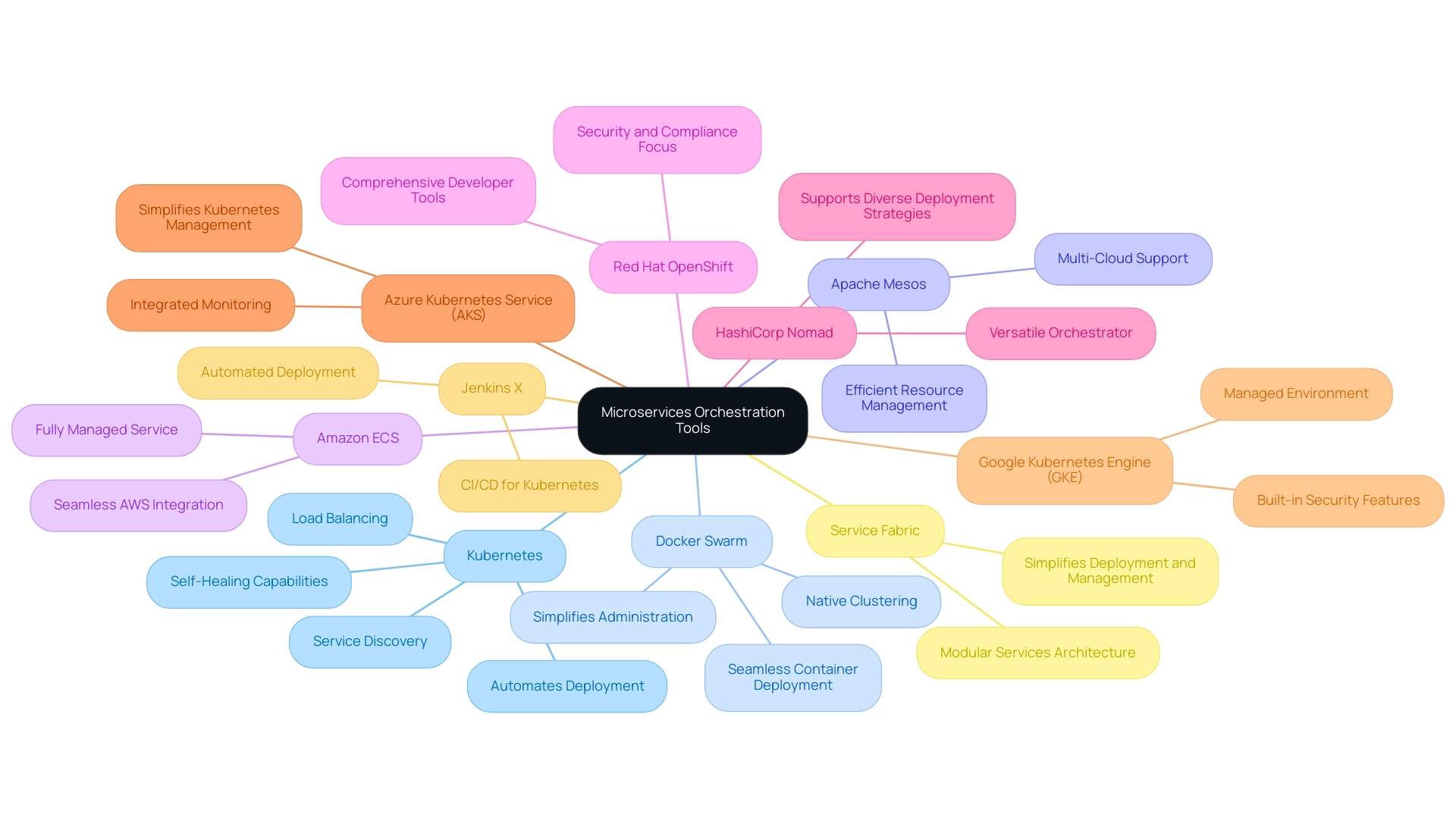
Best Practices for Implementing Microservices Orchestration
Successfully implementing microservices orchestration requires a strategic approach that encompasses several best practices:
- Define Clear Objectives: Establishing specific aims for management resources is paramount. Align these objectives with broader business aims to ensure that the coordination strategy contributes effectively to overall success.
- Choose the Right Resource: Selecting an appropriate orchestration resource necessitates careful consideration of organizational needs. Factors such as scalability, ease of use, and integration capabilities should guide the decision-making process. Microservices orchestration tools, such as Kubernetes, Docker, and Jenkins, are often favored for their robust features and flexibility. According to recent studies, organizations employing these resources have reported up to a 30% increase in deployment speed.
- Invest in Training: Sufficient training for team members is crucial to reduce the learning curve linked with new resources. As highlighted by Partha Sarathi, Director of Engineering at Ancestry, "We only had so many analysts. Statsig provided the necessary tools to remove the bottleneck. I know that we are able to impact our key business metrics in a positive way with Statsig." This emphasizes that effective training can transform operational bottlenecks into streamlined processes, positively impacting key business metrics.
- Monitor Performance: Implementing comprehensive monitoring and logging practices is crucial for tracking the performance of services. Utilizing distributed tracing data can inform architectural improvements, enhancing the efficiency and reliability of service-oriented architectures.
- Prioritize Security: Security should be integrated into the orchestration framework from the beginning. By implementing security best practices, companies can safeguard services from vulnerabilities and ensure data integrity.
- Foster Collaboration: Encouraging collaboration between development and operations teams streamlines workflows and enhances communication. Committed groups concentrating on particular services can enhance performance and collaboration. For instance, a case study on constructing teams around small services revealed that entities dedicating resources to create autonomous groups for each small service reported significant enhancements in inter-service communication and overall project success.
By following these best practices, organizations can create a strong basis for effective service management, paving the way for improved operational efficiency and innovation.
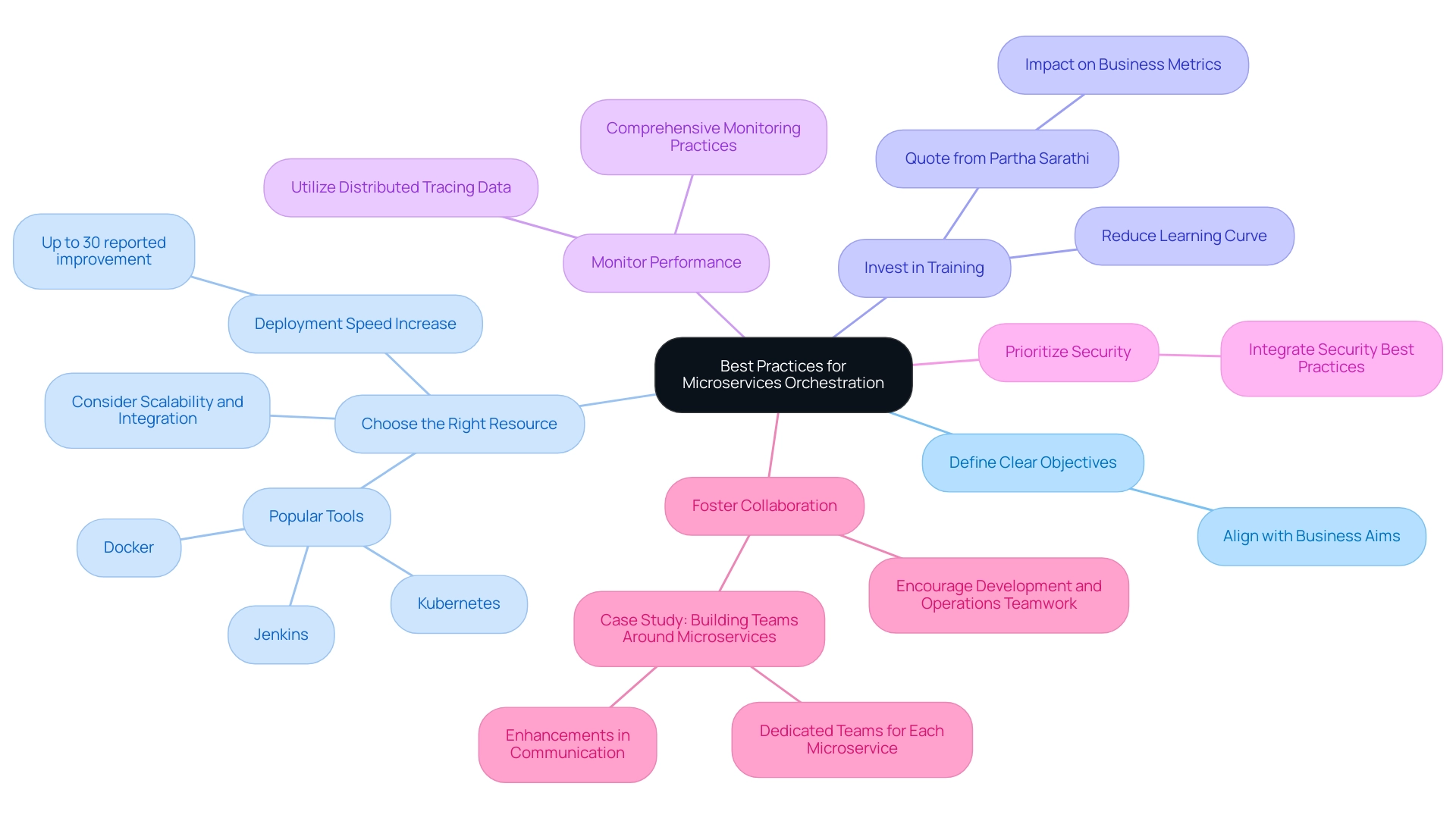
Real-World Use Cases of Microservices Orchestration
-
Netflix: The company employs microservices orchestration tools to effectively manage its extensive library of content and user data. This architecture enables seamless streaming experiences and allows for the rapid deployment of new features, enhancing user satisfaction. Notably, the efficiency of this approach is starkly contrasted with traditional monolithic architectures, which have a network transmission rate of just 3.129852 B/s.
-
Uber: The microservices orchestration tools at Uber coordinate a multitude of services that handle ride requests, payments, and driver interactions. This arrangement is crucial for maintaining efficient operations and ensuring responsiveness to user demands across the platform. As emphasized by Sarita and Sunil, the shift from monolithic systems to distributed architecture is essential for modern applications.
-
Spotify: By utilizing management tools, Spotify oversees its music streaming services to enable quick updates and feature rollouts. This approach ensures high availability and an uninterrupted listening experience for users. Their strategy aligns with the insights from the case study titled "Transforming Monolithic Applications to Microservices," which emphasizes the importance of agile methodologies in development.
-
Airbnb utilizes microservices orchestration tools to streamline various functions, including booking management and payment processing. This arrangement contributes significantly to enhancing the overall user experience by providing reliable and efficient service.
-
eBay employs microservices orchestration tools to navigate its complex architecture, which integrates multiple services. This strategic approach ensures a smooth and cohesive shopping experience for customers, ultimately driving user engagement and satisfaction.
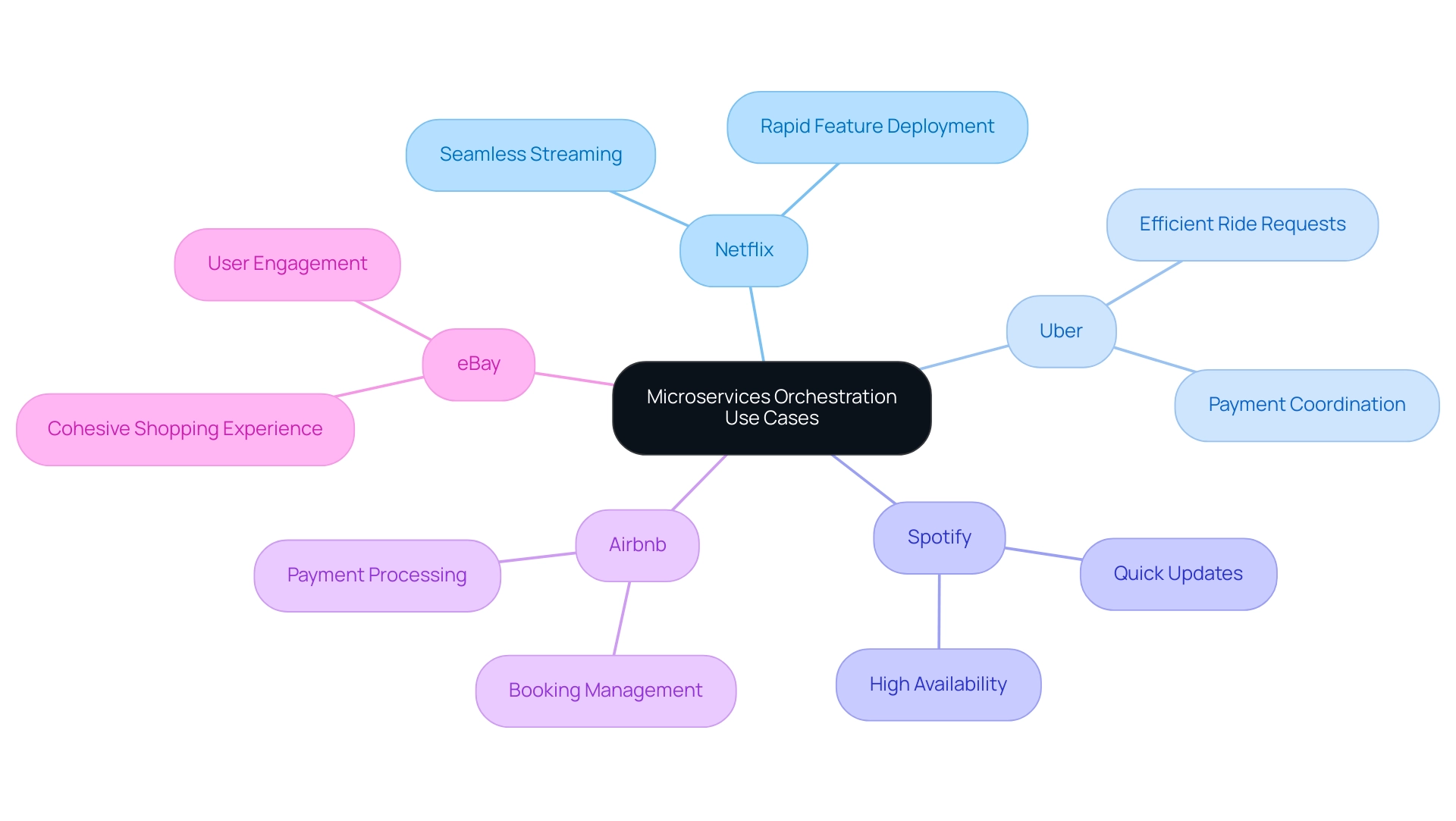
Conclusion
The landscape of microservices orchestration is undeniably transformative, offering organizations the ability to enhance operational efficiency and responsiveness in an increasingly competitive market. By automating the management of microservices, businesses can achieve significant scalability and fault tolerance, enabling them to deploy services rapidly and adapt to ever-changing demands.
While the benefits of microservices orchestration tools—such as improved time-to-market, operational efficiency, and reduced human error—are compelling, it is important to acknowledge the challenges that accompany their implementation. Increased complexity, potential vendor lock-in, and the necessity for robust monitoring must be carefully managed to harness the full potential of these tools. Organizations that prioritize training and foster collaboration between teams are better positioned to navigate these challenges and achieve their orchestration objectives.
As demonstrated through real-world examples from industry leaders like Netflix, Uber, and Spotify, effective microservices orchestration not only streamlines processes but also enhances user experiences. By adopting best practices and leveraging the right tools, organizations can create a solid foundation for innovation and growth. The projected expansion of the microservices orchestration market further highlights its critical role in the future of software development, emphasizing the need for businesses to embrace this paradigm shift to maintain a competitive edge.




